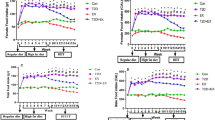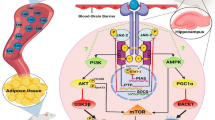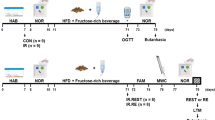Abstract
Alzheimer’s disease (AD) is closely related to type 2 diabetes (T2D). This study investigated the impact of high-intensity interval training (HIIT) on diabetes-induced disturbances in AD-related factors (including AMP-activated protein kinase (AMPK), glycogen synthase kinase-3β (GSK3β), and tau protein) in the hippocampus, with the main focus on adiponectin signaling.
In total, 28 male Wistar rats at the age of 8 weeks were randomly assigned to four groups (n = 7 in each group): control (Con), type 2 diabetes (T2D), HIIT (Ex), and type 2 diabetes + HIIT (T2D + Ex). T2D was induced by a high-fat diet plus a single dose of streptozotocin (STZ). Rats in Ex and T2D + Ex groups performed 8 weeks of HIIT (running at 8–95% of Vmax, 4–10 intervals). Insulin and adiponectin levels in serum and hippocampus were measured along with hippocampal expression of insulin and adiponectin receptors, phosphorylated AMPK, dephosphorylated GSK3β, and phosphorylated tau. Homeostasis model assessment for insulin resistance (HOMA-IR), homeostasis model assessment for insulin resistance beta (HOMA-β), and quantitative insulin sensitivity check index (QUICKI) were calculated to assess insulin resistance and sensitivity. T2D decreased insulin and adiponectin levels in serum and hippocampus, as well as the hippocampal levels of insulin and adiponectin receptors and AMPK, but increased GSK3β and tau in the hippocampus. HIIT reversed diabetes-induced impairments and consequently decreased tau accumulation in the hippocampus of diabetic rats. HOMA-IR, HOMA-β, and QUICKI were improved in Ex and T2D + Ex groups. Overall, our results confirmed that T2D has undesirable effects on the levels of some Alzheimer’s-related factors in the hippocampus, and HIIT could ameliorate these impairments in the hippocampus.
Graphical Abstract







Similar content being viewed by others
Data Availability
All data and material is available at https://kmu.ac.ir/en by request.
Materials Availability
All data and material is available at https://kmu.ac.ir/en by request.
References
Araujo MYC et al (2020) Obesity increases costs with productivity loss due to disability retirements, independent of physical activity: a cohort study. J Occup Environ Med 62(5):325–330
Alford F et al (2018) Glucose effectiveness is a critical pathogenic factor leading to glucose intolerance and type 2 diabetes: an ignored hypothesis. Diabetes Metab Res Rev 34(4):e2989
Mather KJ et al (2008) Adiponectin, change in adiponectin, and progression to diabetes in the Diabetes Prevention Program. Diabetes 57(4):980–986
Maccio A, Madeddu C, Mantovani G (2009) Adipose tissue as target organ in the treatment of hormone-dependent breast cancer: new therapeutic perspectives. Obes Rev 10(6):660–670
Maury E, Brichard S (2010) Adipokine dysregulation, adipose tissue inflammation and metabolic syndrome. Mol Cell Endocrinol 314(1):1–16
Picone P, Di Carlo M, Nuzzo D (2020) Obesity and Alzheimer’s disease: molecular bases. Eur J Neurosci 52(8):3944–3950
Khaleghi M et al (2021) Estrogen attenuates physical and psychological stress-induced cognitive impairments in ovariectomized rats. Brain and Behavior 11(5):e02139
Zare D et al (2021) Inhibition of protease-activated receptor 1 (PAR1) ameliorates cognitive performance and synaptic plasticity impairments in animal model of Alzheimer’s diseases. Psychopharmacology 238(6):1645–1656
Diaz-Kenney RV et al (2010) A historical overview of the United States-Mexico border diabetes prevention and control project. Rev Panam Salud Publica 28(3):143–150
Kadowaki T, Yamauchi T (2005) Adiponectin and adiponectin receptors. Endocr Rev 26(3):439–451
Fang H, Judd RL (2011) Adiponectin regulation and function. Compr Physiol 8(3):1031–1063
Michailidis M et al (2022) Alzheimer’s disease as type 3 diabetes: common pathophysiological mechanisms between Alzheimer’s disease and type 2 diabetes. Int J Mol Sci 23(5):2687
Nguyen TT et al (2020) Type 3 diabetes and its role implications in Alzheimer’s disease. Int J Mol Sci 21(9):3165
Ma J et al (2016) Peripheral blood adipokines and insulin levels in patients with Alzheimer’s disease: a replication study and meta-analysis. Curr Alzheimer Res 13(3):223–233
Teixeira AL et al (2013) Decreased levels of circulating adiponectin in mild cognitive impairment and Alzheimer’s disease. NeuroMol Med 15(1):115–121
Dukic L et al (2016) The role of human kallikrein 6, clusterin and adiponectin as potential blood biomarkers of dementia. Clin Biochem 49(3):213–218
Benavente KS, Raymond P, Royall DR (2018) Serum adiponectin is related to dementia. Am J Geriatr Psychiatry 26(3):S94
Rajizadeh MA et al (2021) Does caffeine therapy improve cognitive impairments in valproic acid rat model of autism? Toxin Reviews 40(4):654–664
Bejeshk M-A et al (2018) Combinatorial effect of lower extremity blood flow restriction and low intensity endurance exercise on aorta of old male rats: histomorphological and molecular approach. Artery Research 24:22–31
Rajizadeh MA et al (2019) The effects of high intensity exercise on learning and memory impairments followed by combination of sleep deprivation and demyelination induced by etidium bromide. Int J Neurosci 129(12):1166–1178
Raji-Amirhasani A et al (2018) Mild exercise along with limb blood-flow restriction modulates the electrocardiogram, angiotensin, and apelin receptors of the heart in aging rats. Iran J Basic Med Sci 21(6):558
Rajizadeh MA et al (2020) Voluntary exercise modulates learning & memory and synaptic plasticity impairments in sleep deprived female rats. Brain Res 1729:146598
Rajizadeh MA et al (2018) Voluntary exercise impact on cognitive impairments in sleep-deprived intact female rats. Physiol Behav 188:58–66
Rajizadeh MA et al (2020) Cognitive impairments of sleep-deprived ovariectomized (OVX) female rats by voluntary exercise. Basic and Clinical Neuroscience 11(5):573
Amirazodi F et al (2020) The combination effects of resveratrol and swimming HIIT exercise on novel object recognition and open-field tasks in aged rats. Exp Aging Res 46(4):336–358
Amirazodi M et al (2022) The effects of combined resveratrol and high intensity interval training on the hippocampus in aged male rats: an investigation into some signaling pathways related to mitochondria. Iran J Basic Med Sci 25(2):254
Kadoglou NP et al (2007) The anti-inflammatory effects of exercise training in patients with type 2 diabetes mellitus. Eur J Prev Cardiol 14(6):837–843
Wewege MA et al (2021) The effect of resistance training in healthy adults on body fat percentage, fat mass and visceral fat: a systematic review and meta-analysis. Sports Med 52(2):287–300
Rajabi A et al (2022) Effect of 8 weeks aerobic training and saffron supplementation on inflammation and metabolism in middle-aged obese women with type 2 diabetes mellitus. Sports 10(11):167
Orumiyehei A et al (2022) High-intensity interval training-induced hippocampal molecular changes associated with improvement in anxiety-like behavior but not cognitive function in rats with type 2 diabetes. Brain Sci 12(10):1280
Khajehlandi M et al (2021) Endurance training regulates expression of some angiogenesis-related genes in cardiac tissue of experimentally induced diabetic rats. Biomolecules 11(4):498
Vardar SA et al (2018) High-intensity interval training acutely alters plasma adipokine levels in young overweight/obese women. Arch Physiol Biochem 124(2):149–155
Racil G et al (2013) Effects of high vs. moderate exercise intensity during interval training on lipids and adiponectin levels in obese young females. Eur J Appl Physiol 113(10):2531–2540
Martínez-Huenchullán SF et al (2020) Constant-moderate versus high-intensity interval training on heart adiponectin levels in high-fat fed mice: a preventive and treatment approach. Arch Physiol Biochem 1–5
Eliza J et al (2009) Antidiabetic and antilipidemic effect of eremanthin from Costus speciosus (Koen.) Sm., STZ-induced diabetic rats. Chemico-Biol Interact 182(1):67–72
Frankenberg ADv, Reis AF, Gerchman F (2017) Relationships between adiponectin levels, the metabolic syndrome, and type 2 diabetes: a literature review. Arch Endocrinol Metab 61:614–622
Parastesh M et al (2019) The effect of aerobic training on serum levels of adiponectin, hypothalamic-pituitary-gonadal axis and sperm quality in diabetic rats. Urol J 16(06):592–597
Rajizadeh MA et al (2019) Anti-inflammatory and anti-oxidative effects of myrtenol in the rats with allergic asthma. Iran J Pharm Res: IJPR 18(3):1488
Sims-Robinson C et al (2010) How does diabetes accelerate Alzheimer disease pathology? Nat Rev Neurol 6(10):551–559
Katz A et al (2000) Quantitative insulin sensitivity check index: a simple, accurate method for assessing insulin sensitivity in humans. J Clin Endocrinol Metab 85(7):2402–2410
Ghiasi R et al (2015) Swim training improves HOMA-IR in type 2 diabetes induced by high fat diet and low dose of streptozotocin in male rats. Adv Pharm Bull 5(3):379
Biessels GJ et al (2020) Understanding multifactorial brain changes in type 2 diabetes: a biomarker perspective. Lancet Neurol 19(8):699–710
Pousti F et al (2018) Adiponectin modulates synaptic plasticity in hippocampal dentate gyrus. Neurosci Lett 662:227–232
Weisz F et al (2017) The role of adiponectin receptors in the regulation of synaptic transmission in the hippocampus. Synapse 71(5):e21964
Hahm JR et al (2020) Metabolic stress alters antioxidant systems, suppresses the adiponectin receptor 1 and induces Alzheimer’s like pathology in mice brain. Cells 9(1):249
Zhao C-J et al (2019) Effect of moxibustion at “Shenque”(CV8) and “Zusanli”(ST36) on expression of adiponectin and adiponectin receptor in Alzheimer’s disease rats. Zhen ci yan jiu = Acupuncture Res 44(6):419–423
Aleidi S et al (2015) Adiponectin serum levels correlate with insulin resistance in type 2 diabetic patients. Saudi Pharm J 23(3):250–256
Wang Y et al (2018) Plasma adiponectin levels and type 2 diabetes risk: a nested case-control study in a Chinese population and an updated meta-analysis. Sci Rep 8(1):1–13
Khoramipour K et al (2021) Metabolomics in exercise and sports: a systematic review. Sports Med 1–37
Ha CH et al (2015) Effects of combined exercise on HOMA-IR, HOMA β-cell and atherogenic index in Korean obese female. Sport Sci Health 11(1):49–55
Shaban N, Kenno K, Milne K (2014) The effects of a 2 week modified high intensity interval training program on the homeostatic model of insulin resistance (HOMA-IR) in adults with type 2 diabetes. J Sports Med Phys Fitness 54(2):203–209
Eizadi M et al (2017) Relationship between TCF7L2 relative expression in pancreas tissue with changes in insulin by high intensity interval training (HIIT) in type 2 diabetes rats. SSU_Journals 24(12):981–993
Hemmatinafar M et al (2013) The effect of high intensity interval training (HIIT) on plasma adiponectin levels, insulin sensitivity and resistance in sedentary young men. J Adv Med Biomed Res 21(84):1–12
de Mello MB et al (2022) Effect of high-intensity interval training protocols on VO2max and HbA1c level in people with type 2 diabetes: a systematic review and meta-analysis. Ann Phys Rehabil Med 65(5):101586
Hobday AL, Parmar MS (2021) The link between diabetes mellitus and tau hyperphosphorylation: implications for risk of Alzheimer’s disease. Cureus 13(9)
Zhang Y et al (2018) Diabetes mellitus and Alzheimer’s disease: GSK-3β as a potential link. Behav Brain Res 339:57–65
Kubota N et al (2007) Adiponectin stimulates AMP-activated protein kinase in the hypothalamus and increases food intake. Cell Metab 6(1):55–68
Rashtiani S et al (2021) Adenosine monophosphate activated protein kinase (AMPK) is essential for the memory improving effect of adiponectin. Neurosci Lett 749:135721
Barone E et al (2021) The interplay among oxidative stress, brain insulin resistance and AMPK dysfunction contribute to neurodegeneration in type 2 diabetes and Alzheimer disease. Free Radical Biol Med 176:16–33
Apró W et al (2015) Resistance exercise-induced S6K1 kinase activity is not inhibited in human skeletal muscle despite prior activation of AMPK by high-intensity interval cycling. Am J Physiol-Endocrinol Metab 308(6):E470–E481
Bartlett JD et al (2012) Matched work high-intensity interval and continuous running induce similar increases in PGC-1α mRNA, AMPK, p38, and p53 phosphorylation in human skeletal muscle. J Appl Physiol 112(7):1135–1143
Nigam SM et al (2017) Exercise and BDNF reduce Aβ production by enhancing α-secretase processing of APP. J Neurochem 142(2):286–296
Yong J et al (2021) Adiponectin as well as compressive forces regulate in vitro β-catenin expression on cementoblasts via mitogen-activated protein kinase signaling activation. Front Cell Dev Biol 9:874
Leng S et al (2010) Glycogen synthase kinase 3β mediates high glucose-induced ubiquitination and proteasome degradation of insulin receptor substrate 1. J Endocrinol 206(2):171
Salcedo-Tello P, Ortiz-Matamoros A, Arias C (2011) GSK3 function in the brain during development, neuronal plasticity, and neurodegeneration.Int J Alzheimer’s disease 2011:189728. https://doi.org/10.4061/2011/189728
Pei J-J et al (1997) Distribution, levels, and activity of glycogen synthase kinase-3 in the Alzheimer disease brain. J Neuropathol Exp Neurol 56(1):70–78
Thota RN et al (2020) Dietary supplementation with curcumin reduce circulating levels of glycogen synthase kinase-3β and islet amyloid polypeptide in adults with high risk of type 2 diabetes and Alzheimer’s disease. Nutrients 12(4):1032
Acknowledgements
We would like to thank the Physiology Research Center and Neuroscience Research Center of Kerman University of Medical sciences for their financial help.
Funding
This study was funded by Physiology Research Center and Neuroscience Research Center of Kerman University of Medical Sciences (grants No. 99000443 and 99–42).
Author information
Authors and Affiliations
Contributions
All authors contributed to the study’s conception and design. Material preparation, data collection, and analysis were performed by Kayvan Khoramipour, Mohammad Abbas Bejeshk, and Mohammad Amin Rajizadeh. The first draft of the manuscript was written by Kayvan Khoramipour, Mohammad Abbas Bejeshk, and Mohammad Amin Rajizadeh. All authors commented on previous versions of the manuscript. All authors read and approved the final manuscript.
Corresponding author
Ethics declarations
Ethics Approval
This study was performed in line with the principles of the Declaration of Helsinki. Approval was granted by the ethics committee of KUMS (ethics approval code: IR.KMU.REC.1399.503).
Research involving Human Participants and/or Animals
Yes.
Consent to Participate
Not applicable.
Consent for Publication
Not applicable.
Competing Interests
The authors declare no competing interests.
Additional information
Publisher's Note
Springer Nature remains neutral with regard to jurisdictional claims in published maps and institutional affiliations.
Rights and permissions
Springer Nature or its licensor (e.g. a society or other partner) holds exclusive rights to this article under a publishing agreement with the author(s) or other rightsholder(s); author self-archiving of the accepted manuscript version of this article is solely governed by the terms of such publishing agreement and applicable law.
About this article
Cite this article
Khoramipour, K., Bejeshk, M.A., Rajizadeh, M.A. et al. High-Intensity Interval Training Ameliorates Molecular Changes in the Hippocampus of Male Rats with the Diabetic Brain: the Role of Adiponectin. Mol Neurobiol 60, 3486–3495 (2023). https://doi.org/10.1007/s12035-023-03285-z
Received:
Accepted:
Published:
Issue Date:
DOI: https://doi.org/10.1007/s12035-023-03285-z




